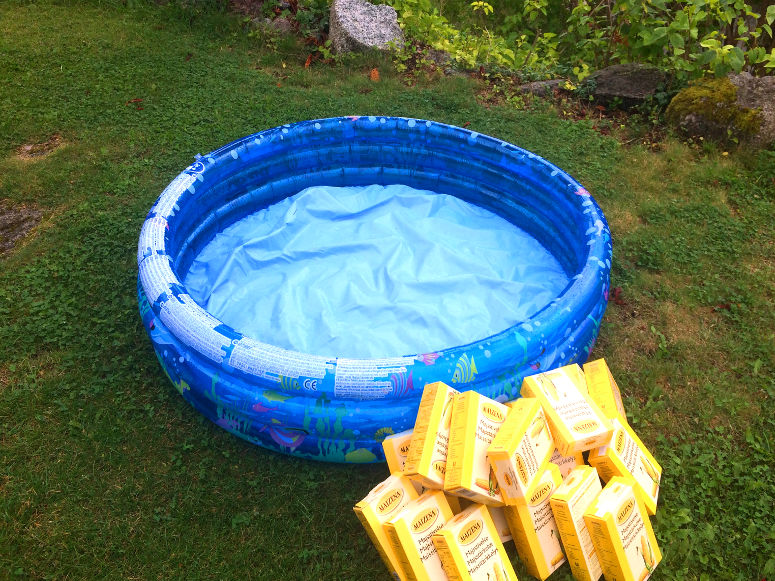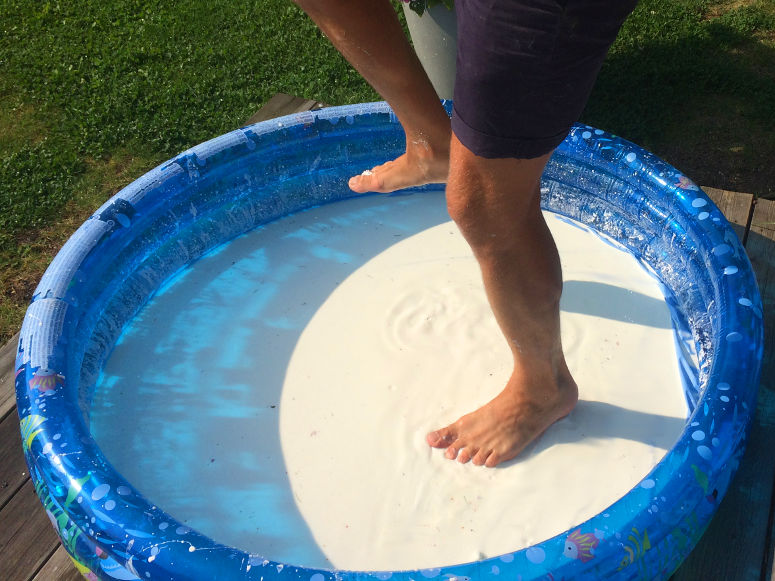Fun and easy science experiments for kids and adults.
Chemistry
The slime that is both solid and liquid - at the same time. This is an experiment about states of matter and mixtures.
| Gilla: | Dela: | |
Video

Materials
- 1 package of corn stach, about 400 g (14 oz)
- 1 large bowl
- Water
Warning!
Do not pour the mixture of corn starch and water down the drain! It can cause a clog. Instead, throw it in the trash.Step 1


Step 2


Step 3


Step 4


Short explanation
Corn starch and water in the right amounts form a non-Newtonian fluid. Such a fluid becomes more liquid or more solid when under force - in this case more solid.Long explanation
This mixture is often called oobleck after Bartholomew and the Oobleck, a children's book by Dr. Seuss about a boy who has to save his kingdom from a green goo that is raining down from the sky. Oobleck is a so-called non-Newtonian fluid. The name means that the fluid doesn't behave as the great physicist Isaac Newton described. He stated that the viscosity of a fluid, i.e. its "inertia", depends only on the temperature.There are some different types of non-Newtonian fluids, whose viscosity depends on different things besides temperature. Oobleck belongs to the type whose viscosity also depends on how much the fluid is displaced, i.e. how much a part of the fluid moves in relation to another part. The more the fluid is displaced, for example when you hit it, the more viscous it becomes. Oobleck is a mixture of water and corn starch where the corn starch doesn't dissolve completely in the water, but exists as microscopically small lumps. In chemical terms - the corn starch and the water are still in separate phases. Because there is so much corn starch in the mixture, these lumps are so numerous that they touch each other. If you slowly lower a finger into the mixture, they have time to slide out of the way and make room for the finger. The mixture behaves as if it was liquid. But if you quickly lower your finger, they don't have time to move away - they need some time because they are relatively heavy - and remain in place. The mixture behaves as if it was solid. Oobleck can thus be both solid and liquid at the same temperature. It's easy to clean up oobleck. Hot water is sufficient. If you get it on your clothes, you can let them dry and then brush it off.
Experiment
You can turn this demonstration into an experiment. This will make it a better science project. To do that, try answering one of the following questions. The answer to the question will be your hypothesis. Then test the hypothesis by doing the experiment.- What happens if you hit the oobleck?
- What happens if you squeeze the oobleck hard and then release it?
- What happens if you slowly lower your hand into the oobleck and then quickly try to pull it back?
- What happens if you try to bounce a ball on the surface?
- What happens if you pour the mixture and then cut the resulting "string" with a pair of scissors?
- What happens if you try to swing the bowl back and forth?
- What happens if you leave a glass of oobleck for a long time?
- What happens if you change the amount of water in the mix?
- What happens if you use some other liquid instead of water, such as milk or soda?
- What happens if you use some other powder, such as potato starch or wheat flour?
Variations
If the demonstration is not fun enough, you can mix in a little food coloring. Everything gets better with food coloring.If the demonstration is done on a large scale, you can walk on the mixture. All that's needed is an empty children's pool and 15-20 packages of corn starch.




| Gilla: | Dela: | |
Similar
Latest
Content of website
© The Experiment Archive. Fun and easy science experiments for kids and adults. In biology, chemistry, physics, earth science, astronomy, technology, fire, air and water. To do in preschool, school, after school and at home. Also science fair projects and a teacher's guide.
To the top
© The Experiment Archive. Fun and easy science experiments for kids and adults. In biology, chemistry, physics, earth science, astronomy, technology, fire, air and water. To do in preschool, school, after school and at home. Also science fair projects and a teacher's guide.
To the top

































































































































